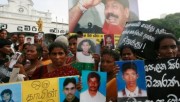Enforced Disappearances in Sri Lanka
Every single day, all over the world – “People literally disappear, from their loved ones and their community, when state officials (or someone acting with state consent) grab them from the street or from their homes and then deny it, or refuse to say where they are.” (“Disappearances”) Families are being torn apart, children are growing up without parent figures, and justice isn’t being served to those that are affected. Hundreds of thousands of people have been forced to disappear and that leaves a greater number of loved ones to be in the dark. Many of these people can’t find peace until they know what’s happened to those that have gone missing. It is said that Sri Lanka, as a whole, can’t heal until justice and truth have been served.
NGOs working on the issue
- Amnesty International
Links to additional relevant NGOs
Related Books
- ‘Disappearance’ and ‘Displacement’ in Sri Lanka by: Malathi de Alwis
- Documenting Stories of Forced Disappearances in Sri Lanka
Ideas for helping out with the issue
- Bring international attention to the issue
- Get the Government of Sri Lanka to acknowledge and recognize the disappearances
- Petition for the United Nations/International Government to give consequences
Academic Articles:
- Brody, Reed and Felipe González. “Nunca Mas: An Analysis of International Instruments on “Disappearances.” Human Rights Quarterly, vol. 19, no. 2, May 1997, pp. 365-405. EBSCOhost.
– This academic journal discusses the background of forced disappearances within a global perspective. It goes into depth explaining more about what kinds of people have disappeared. This helped me understand what a detainee goes through and what extent of harm can come to those that are taken and the people that are being taken away from. It sucks to see how easily it was for people to disappear, but how extensive that effects are on everyone.
- Schwab, Gabriele. “Unofficial Wars: The Politics of Disappearance.” European Review, vol. 22, no. 4, 2014, pp. 642-651, Advanced Technologies & Aerospace Database; Agricultural & Environmental Science Database; Earth, Atmospheric & Aquatic Science Database; Materials Science & Engineering Database; Social Science Premium Collection.
– This article uses specific populations to talk about the enforced disappearances. It discusses the problem in Sri Lanka to go more in-depth about how it occurs globally. This source is important because it shows examples straight from the country that is being investigated and connects it to a broader scale to show how massive the issue truly is.
Academic Books:
- De, Alwis M. “‘Disappearance’ and ‘Displacement’ in Sri Lanka.” Journal of Refugee Studies. 22.3 (2009): 378-391. Print.
- ”Documenting Stories of Forced Disappearances in Lanka.” The Hindu (english). (2013). Print.
Working Paper on the SSRN Website:
- Gupta, Rashi Shailesh, Recognition of Insurgent and Belligerent Organisations in International Law (April 23, 2014).
– This paper discusses the idea of insurgent, belligerent, and terrorist organizations. The people who are forced to disappear in Sri Lanka are those that are opposed to the government and government groups. Reading this paper is helpful because having a background of what it means to be an insurgent or belligerent organization, would allow for a better understanding of what type of people are targets.
Leading Scholar in the Field:
- Punyasena, Wasana. “The Facade of Accountability: Disappearances in Sri Lanka.” Boston College Third World Law Journal 23.1 (2003): 115-158.
– This note analyzes disappearances through an in-depth case study. It talks about the background of disappearances and what effective methods have been used to obtain justice. It also discusses a case study that took place in Sri Lanka and looked to understand the main reason behind the divide within the country and its people.
Poetry:
- de Alwis, Malathi, et al. “Forced Disappearances in Sri Lanka Poems.” Amnesty International. Accessed 12 Sept. 2017.
– These are the 5 poems in English that won the Amnesty International competition. The main topic that the poems needed to surround is the enforced disappearances in Sri Lanka. It’s interesting how light can be brought to the issue through art, even though it’s such a serious problem.
Videos:
- Manimekalai, Leena, and Leena Manimekalai. YouTube, YouTube, 14 Oct. 2013. Accessed 12 Sept. 2017.
– White Van Stories is a documentary about the history of enforced disappearances in Sri Lanka. It interviews people that have been affected by these acts. It will give the audience a better understanding of how it affects people, and give a more personal perspective.
- YouTube, Youtube, 20 Oct. 2015. Accessed 12 Sept. 2017.
NGOs Working on this Issue:
- Amnesty International
– Amnesty International is the leading NGO working on enforced disappearances in Sri Lanka. With various new articles, blogs, campaigns, and educational programs, their objective is to call for the action of governments to end this gross human rights violation. Specifically in reference to Sri Lanka, their work includes documenting the current events pertaining to the enforced disappearances.
- United Nations Human Rights Office of the High Commission: Sri Lanka
Government and IGO Reports:
- United Nations Economic and Social Council: CIVIL AND POLITICAL RIGHTS, INCLUDING THE QUESTIONS OF: DISAPPEARANCES AND SUMMARY EXECUTIONS United Nations Economic and Social Council. “Report.” United Nations Economic and Social Council, 30 Jan. 2001.
– Following the gross abuses of human rights by the government, the United Nations Economic and Social Council completed an investigation regarding the enforced disappearances. This source is of extreme value as is delineates not only the damage done to the community, but also the goals of ECOSOC.
- United States Institute of Peace- Commissions of Inquiry into the Involuntary Removal or Disappearance of Persons: Sri Lanka “Commissions of Inquiry: Sri Lanka.” United States Institute of Peace, 1 May 2013. Accessed 12 Sept. 2017.
Events Related to this Issue:
- August 30: International Day of the Victims of Enforced Disappearances
Social Media Sources:
- IFJ Blog: Disappearances of Journalists in Sri Lanka
“IFJ Blog: Disappearances of Journalists in Sri Lanka: Lessons Learned.” Titel des. Accessed 12 Sept. 2017.
- #StopDisappearances
– This hashtag is a resource provided by Amnesty International. To support International Day of the Disappeared, this hashtag was created to spread awareness not only about Sri Lanka, but about the many nations afflicted with this issue.
Images:
- “Protestors in Sri Lanka.” Digital Image.
- “The Disappeared.” Digital image.
– This infamous image is a wall of “The Disappeared”. It is where many go to put images of their loved ones who have been abducted. Many have never heard from them again, nor will they probably ever again. The purpose of the wall serves more as a protest to the government and a reminder for the horrors the society has endured.
- “White Van Abduction.” Digital Image.
– “White Van Abductions” are characteristic of the Sri Lankan government; this image was captured during a protest when many activists were abducted and never seen from again. Their whereabouts remains unknown and unreported by the government. It is a rare photograph and one of the few ever documented of the many enforced disappearances.
Maps:
- “A Map of The Disappeared.” Digital Image.
Websites:
- “Disappearances.” Amnesty International. Accessed 12 Sept. 2017.
- Enforced and Involuntary Disappearances in Sri Lanka. pp. 2–4, Enforced and Involuntary Disappearances in Sri Lanka. Accessed 12 Sept. 2017.
– This is a submitted written statement by The International Movement Against All Forms of Discrimination and Racism at the 33rd session of the Human Rights Council. It explains the concerns about what is happening in Sri Lanka and what can be done about the enforced disappearances. It gives detailed, in-depth information about the problems and it’s useful in educating somebody about what is still occurring in Sri Lanka.
- “Enforced Disappearances in Sri Lanka: 2006-2013.” Groundviews, 9 Jan. 2014. Accessed 12 Sept. 2017.
- “Recurring Nightmare.” Human Rights Watch, 24 June 2015. Accessed 12 Sept. 2017.

